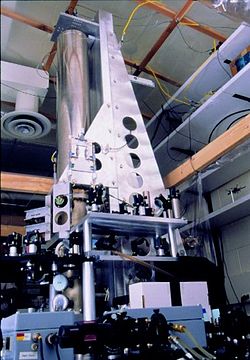- NIST-F1
-
NIST-F1 is a cesium fountain clock or atomic clock in the National Institute of Standards and Technology (NIST) in Boulder, Colorado, and serves as the United States' primary time and frequency standard. The clock took less than four years to test and build, and was developed by Steve Jefferts and Dawn Meekhof of the Time and Frequency Division of NIST's Physical Measurement Laboratory.[1]
The clock replaces NIST-7, a cesium beam atomic clock used from 1993 to 1999. NIST-F1 is ten times more accurate than NIST-7. NIST-F1 will be replaced by the NIST-F2.[1]
Contents
Frequency measurement
The apparatus consists of counter-propagating lasers that cool and trap a gas of cesium atoms. Once trapped, two vertical lasers propel the atoms upward inside a microwave chamber. Depending on the exact frequency of the microwaves, the cesium atoms will reach an excited state. Upon passing through a laser beam, the atoms will fluoresce (emit photons). The microwave frequency which produces maximum fluorescence is used to define the second.[1]
Similar atomic fountain clocks, with comparable accuracy, are operated by other time and frequency laboratories, such as the Paris Observatory, the National Physical Laboratory (NPL) in the United Kingdom and the Physikalisch-Technische Bundesanstalt in Germany.[1]
Accuracy
As of 2010, the clock's uncertainty was about 3 x 10-16
. It is expected to neither gain nor lose a second in more than 100 million years.[1]References
- ^ a b c d e "NIST-F1 Cesium Fountain Atomic Clock: The Primary Time and Frequency Standard for the United States". NIST. August 26, 2009. http://www.nist.gov/pml/div688/grp50/primary-frequency-standards.cfm. Retrieved 2 May 2011.
External links
- U.S. Atomic Time
- S R Jefferts, J Shirley, T E Parker, T P Heavner, D M Meekhof, C Nelson, F Levi, G Costanzo, A De Marchi, R Drullinger, L Hollberg, W D Lee and F L Walls (2002). "Accuracy evaluation of NIST F-1". Metrologia 39 (4): 321–336. Bibcode 2002Metro..39..321J. doi:10.1088/0026-1394/39/4/1. http://www.boulder.nist.gov/timefreq/general/pdf/1823.pdf.
Categories:
Wikimedia Foundation. 2010.

